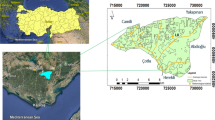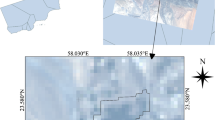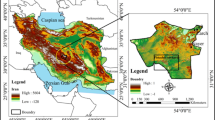Abstract
Evapotranspiration (ET) is an important hydrological variable for better irrigation management, water budgeting, and runoff estimation which should be estimated as precisely as possible both in space and time. However, most of the available crop coefficient-based ET computation methods provide point-scale estimates which need upscaling to apply at the catchment or command area scale. This study evaluates the applicability of the simplified surface energy balance index (S-SEBI) method to compute the spatially distributed daily ET in the Kangsabati reservoir command in eastern India considering the crop coefficient-based coupled Hargreaves–Samani (ETc_HG) method as the benchmark. The study is based on two major crops of paddy and potato in the Rabi season of 2015 at 100 surveyed ground truth locations in the selected command area having different crop growth stages and using the site-specific Landsat 8 images on three cloud-free dates. The S-SEBI method shows improved ET estimates during the crop development stage characterized by higher canopy cover than that during the initial crop development stage with lesser canopy cover that traps less radiation. Results revealed that S-SEBI-based ET estimates correlated well with ETc_HG with r and RMSE value of 0.06 and 1.13 mm/day (initial stage), 0.71 and 0.52 mm/day (development stage) and 0.77 and 0.52 (maturity stage) for paddy. The r and RMSE value for potato is found to be better during the development stage (0.43, 0.69 mm/day) than the initial stage (0.17, 0.64 mm/day) in a similar trend with paddy. Therefore, the crop coefficient-based method could be advantageous at point-scale with adequate data availability conditions, whereas the S-SEBI method could be used in data-scarce areas to estimate the spatially distributed ET values.








Similar content being viewed by others
References
Adamala, S., & Srivastava, A. (2018). Comparative evaluation of daily evapotranspiration using artificial neural network and variable infiltration capacity models. Agricultural Engineering International: CIGR Journal, 20(1), 32–39.
Allen, R. G., Pereira, L. S., Raes, D., & Smith, M. (1998). Crop evapotranspiration. Guidelines for computing crop water requirements. FAO irrigation and drainage paper no. 56. Rome: Food and Agricultural Organization of the United Nations.
Bala, A., Rawat, K. S., Misra, A. K., & Srivastava, A. (2016). Assessment and validation of evapotranspiration using SEBAL algorithm and Lysimeter data of IARI agricultural farm, India. Geocarto International, 31(7), 739–764.
Bandyopadhyay, A., Bhadra, A., Swarnkar, R. K., Raghuwanshi, N. S., & Singh, R. (2012). Estimation of reference evapotranspiration using user-friendly decision support system: DSS_ET. Agricultural and Forest Meteorology, 154–155, 19–29.
Bandyopadhyay, P. K., & Mallick, S. (2003). Actual evapotranspiration and crop coefficients of wheat (Triticum aestivum) under varying moisture levels of humid tropical canal command area. Agricultural Water Management, 59, 33–47.
Bastiaanssen, W. G. M. (2000). SEBAL-based sensible and latent heat fluxes in the irrigated Gediz Basin, Turkey. Journal of Hydrology, 229, 87–100.
Bastiaanssen, W. G. M., Menenti, M., Feddes, R. A., & Holstlag, A. A. M. (1998). A remote sensing surface energy balance algorithm for land (SEBAL), 1. Formation. Journal of Hydrology, 212(213), 198–212.
Blaney, H. F., & Criddle, W. D. (1950). Determination of water requirements in irrigated area from climatological irrigation data (Vol. Soil Conservation Service Technical Paper, pp. 48). US Department of Agriculture.
Danodia, A., Patel, N. R., Nikam, B. R., Chol, C. W., & Sehgal, V. K. (2019). Application of S-SEBI model for crop evapotranspiration using Landsat-8 data over parts of North India. Geocarto International, 34(1), 114–131.
Dile, Y. T., Ayana, E. K., Worqlul, A. W., Xie, H., Srinivasan, R., Lefore, N., et al. (2020). Evaluating satellite-based evapotranspiration estimates for hydrological applications in data-scarce regions: A case in Ethiopia. Science of the Total Environment, 743, 140702.
Djaman, K., O’Neill, M., Diop, L., Bodian, A., Allen, S., & Kaudahe, K. (2018). Evaluation of the Penman–Monteith and other 34 reference evapotranspiration equations under limited data in a semiarid dry climate. Theoretical and Applied Climatology, 143(8), 04017028.
Doorenbos, J., & Pruitt, W. O. (1977). Guidelines for prediction of crop water requirements. FAO irrigation and drainage paper no. 24 (revised). Rome: Food and Agricultural Organization of the United Nations.
dos Santos, C. A. C., Bezerra, B. G., da Silva, B. B., & Rao, T. V. R. (2010). Assessment of daily actual evapotranspiration with SEBAL and S-SEBI algorithms in cotton crop. Revista Brasileira de Meteorologia, 25(3), 383–392.
Elbeltagi, A., Aslam, M. R., Malik, A., Mehdinejadiani, B., Srivastava, A., Bhatia, A. S., et al. (2020). The impact of climate changes on the water footprint of wheat and maize production in the Nile Delta (p. 140770). Egypt: EScience of the Total Environment.
Garcia, M., Villagarcia, L., Contreras, S., Domingo, F., & Puigdefabregas, J. (2007). Comparison of three operative models for estimating the surface water deficit using ASTER reflective and thermal data. Sensors, 7(6), 860–883.
Gomez, M., Olioso, A., Sobrino, J. A., & Jacob, F. (2005). Retrieval of evapotranspiration over the Alpilles/ReSeDA experimental site using airborne POLDER sensor and a thermal camera. Remote Sensing of Environment, 96(3–4), 399–408.
Guler, M. (2014). A Comparison of different interpolation methods using the geographical information system for the production of reference evapotranspiration maps in Turkey. Journal of the Meteorological Society of Japan, 92(3), 227–240.
Jin, X., Wan, L., & Su, Z. (2005). Research on evaporation of Taiyuan basin area by using remote sensing. Hydrology and Earth System Sciences Discussions, 2(1), 209–227.
Kumari, N., & Srivastava, A. (2019). An approach for estimation of evapotranspiration by standardizing parsimonious method. Agricultural Research. https://doi.org/10.1007/s40003-019-00441-7.
Lian, J., & Huang, M. (2015). Evapotranspiration estimation for an oasis area in the Heihe River Basin using Landsat-8 images and the METRIC model. Water Resource Management, 29(14), 5157–5170.
Liang, S. (2000). Narrowband to broadband conversions of land surface albedo I algorithms. Remote Sensing of Environment, 76, 213–238.
Mattar, C., Franch, B., Sobrino, J. A., Corbari, C., JiménezMunoz, J. C., Olivera-Guerra, L., et al. (2014). Impacts of the broadband albedo on actual evapotranspiration estimated by S-SEBI model over an agricultural area. Remote Sensing of Environment, 147, 23–42.
Pandey, P. K., Dabral, P. P., & Pandey, V. (2016). Evaluation of reference evapotranspiration methods for the northeastern region of India. International Soil and Water Conservation Research, 4(1), 52–63.
Patel, N. R., Rakhesh, D., & Mohammed, A. J. (2006). Mapping of regional evapotranspiration in wheat using Terra/MODIS satellite data. Hydrological Sciences Journal, 51(2), 325–335.
Paul, S., Banerjee, C., & Kumar, D. N. (2020). Evaluation framework of landsat 8–based actual evapotranspiration estimates in data-sparse catchment. Journal of Hydrologic Engineering, 25(9), 04020043.
Raziei, T., & Pereira, L. S. (2013). Spatial variability analysis of reference evapotranspiration in Iran utilizing fine resolution gridded datasets. Agricultural Water Management, 126, 104–118.
Roerink, G. J., Su, Z., & Menenti, M. (2000). S-SEBI: A simple remote sensing algorithm to estimate the surface energy balance. Physics and chemistry of the Earth, Part B: Hydrology, oceans and Atmosphere, 25, 147–157.
Rouse, J.W., Haas, R.H., Schell, J.A., & Deering, D.W. (1973). Monitoring vegetation system in great plains with ERTS. In Proceeding 3rd ERTS-1 symposium (pp. 48–62). GSFC, NASA, SP-351.
Roy, S. (2016). Estimation of crop coefficient from remote sensing data to improve irrigation scheduling. Food security project report, Agricultural and Food Engineering Department, Indian Institute of Technology, Kharagpur, India.
Sahoo, B., Walling, I., Deka, B. C., & Bhatt, B. P. (2012). Standardization of reference evapotranspiration models for a sub-humid valley rangeland in the Eastern Himalayas. Journal of Irrigation and Drainage Engineering, 138(10), 880–895.
Sellers, P. J. (1985). Canopy reflectance, photosynthesis, and transpiration. International Journal of Remote Sensing, 6, 1335–1372.
Shwetha, H. R., & Kumar, D. N. (2020). Estimation of daily actual evapotranspiration using vegetation coefficient method for clear and cloudy sky conditions. IEEE Journal of Selected Topics in Applied Earth Observations and Remote Sensing, 13, 2385–2395.
Singh, R. P., Paramanik, S., & Bhattacharya, B. K. (2020). Modelling of evapotranspiration using land surface energy balance and thermal infrared remote sensing. Tropical Ecology, 61, 42–50.
Sobrino, J. A., Gómez, M., Jiménez-Muñoz, J. C., Olioso, A., & Chehbouni, G. (2005). A simple algorithm to estimate evapotranspiration from DAIS data: Application to the DAISEX campaigns. Journal of Hydrology, 315(1–4), 117–125.
Sobrino, J. A., Jiménez-Munoz, J. C., Sòria, G., Romaguera, M., Guanter, L., Moreno, J., et al. (2008). Land surface emissivity retrieval from different VNIR and TIR sensors. IEEE Transactions on Geoscience and Remote Sensing., 46, 316–327.
Sobrino, J. A., Kharraz, J. E., & Li, Z. L. (2004). Surface temperature and water vapour retrieval from MODIS data. International Journal of Remote Sensing, 24, 5161–5182.
Srivastava, A., Deb, P., & Kumari, N. (2020a). Multi-model approach to assess the dynamics of hydrologic components in a tropical ecosystem. Water Resources Management, 34, 327–341.
Srivastava, A., Kumari, N., & Maza, M. (2020b). Hydrological response to agricultural land use heterogeneity using variable infiltration capacity model. Water Resources Management. https://doi.org/10.1007/s11269-020-02630-4.
Srivastava, A., Sahoo, B., Raghuwanshi, N. S., & Chatterjee, C. (2018). Modelling the dynamics of evapotranspiration using variable infiltration capacity model and regionally-calibrated Hargreaves approach. Irrigation Science, 36, 289–300.
Srivastava, A., Sahoo, B., Raghuwanshi, N. S., & Singh, R. (2017). Evaluation of variable infiltration capacity model and MODIS-terra satellite-derived grid-scale evapotranspiration estimates in a river basin with tropical monsoon-type climatology. Journal of Irrigation Drainage Engineering, 143(8), 04017028.
Thornthwaite, C. W. (1948). An approach toward a rational classification of climate. The Geographical Review, 38, 55–94.
Vanderlinden, K., Giraldez, J. V., & Van Meirvenne, M. (2004). Assessing reference evapotranspiration by the Hargreaves method in southern Spain. Journal of Irrigation and Drainage Engineering, 130(3), 184–191.
Wagle, P., Bhattarai, N., Gowda, P. H., & Kakani, V. G. (2017). Performance of five surface energy balance models for estimating daily evapotranspiration in high biomass sorghum. ISPRS Journal of Photogrammetry and Remote Sensing, 128, 192–203.
Wambura, F. J., & Dietrich, O. (2020). Analysis of agricultural drought using remotely sensed evapotranspiration in a data-scarce catchment. Water, 12(4), 998.
Zanetti, S. S., Dohler, R. E., Cecílio, R. A., Pezzopane, J. E. M., & Xavier, A. C. (2019). Proposal for the use of daily thermal amplitude for the calibration of the Hargreaves–Samani equation. Journal of Hydrology, 571, 193–201.
Zhang, K., Kimball, J. S., & Running, S. W. (2016). A review of remote sensing based actual evapotranspiration estimation. Wiley Interdisciplinary Reviews: Water, 3(6), 834–853.
Zhang, Y. K., & Schilling, K. E. (2006). Increasing streamflow and baseflow in Mississippi River since the 1940 s: Effect of land use change. Journal of Hydrology, 324(1–4), 412–422.
Zwart, S. J., & Bastiaanssen, W. G. M. (2007). SEBAL for detecting spatial variation of water productivity and scope for improvement in eight irrigated wheat systems. Agricultural Water Management, 89, 287–296.
Acknowledgments
This work is carried at IIT Kharagpur. A part of the work is carried out as Master’s thesis work, while the remaining has been carried out under Professional Attachment Training (PAT). We acknowledge the Ministry of Human Resources Development and IIT Kharagpur for providing the necessary fellowship and facility during M.Tech. as well as Indian Council of Agricultural Research (ICAR), New Delhi, and ICAR-Vivekananda Parvatiya Krishi Anusandhan Sansthan, Almora 263601 for providing financial support during PAT. We also acknowledge the Agricultural and Food Engineering Department, IIT Kharagpur, for providing necessary technical facilities during the course of investigation. We thank the Editor, Associate Editor, and two anonymous reviewers for their comments, which contributed to improving the previous version of this paper.
Author information
Authors and Affiliations
Corresponding author
Additional information
Publisher's Note
Springer Nature remains neutral with regard to jurisdictional claims in published maps and institutional affiliations.
About this article
Cite this article
Kumar, U., Sahoo, B., Chatterjee, C. et al. Evaluation of Simplified Surface Energy Balance Index (S-SEBI) Method for Estimating Actual Evapotranspiration in Kangsabati Reservoir Command Using Landsat 8 Imagery. J Indian Soc Remote Sens 48, 1421–1432 (2020). https://doi.org/10.1007/s12524-020-01166-9
Received:
Accepted:
Published:
Issue Date:
DOI: https://doi.org/10.1007/s12524-020-01166-9




